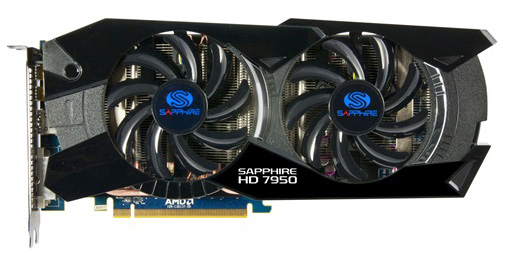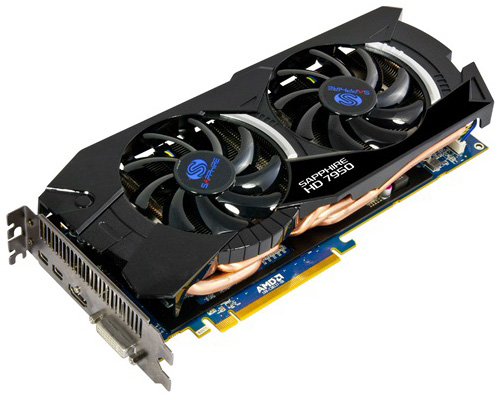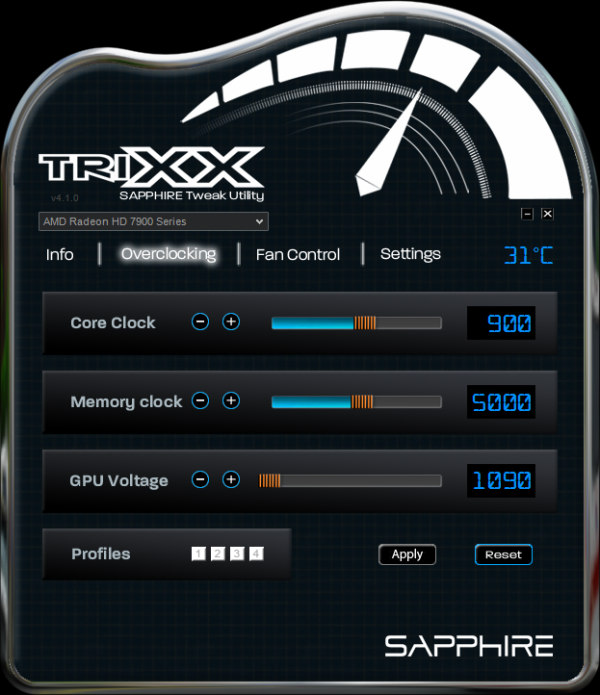AMD Radeon HD 7950 Review Feat. Sapphire & XFX: Sewing Up The High-End Market
by Ryan Smith on January 31, 2012 9:02 AM ESTMeet the Sapphire HD 7950 Overclock Edition
Since our reference 7950s are built on the 7970 PCB and cooler, we’re going to jump right into our vendor cards starting with the Sapphire HD 7950 Overclock Edition.
As with all of the 7950 cards launching today, Sapphire’s HD 7950 Overclock Edition uses the AMD 7950 PCB. This is a slightly shorter PCB measuring 10.25” long, saving .25” over the 7970 PCB by eliminating a few components that the lower board power of the 7950 makes unnecessary. The PCB is otherwise very similar to the 7970 PCB, utilizing 12 GDDR5 memory chips organized around the Tahiti GPU, while at the top you’ll find the 2 CrossFire connectors, a pair of 6pin PCIe power sockets, and the BIOS selection switch. The latter will be of particular interest to unlockers, as the switch should make it possible to safely attempt to unlock the 7950 into a 7970.

Moving on, as this is a semi-custom card the real differentiation is in the factory overclock and the cooler. On the performance side of things Sapphire will be shipping the 7950 Overclock Edition at 900MHz core and 5GHz memory, representing a 100MHz (12.5%) core overclock and no change on the memory clock.
Meanwhile for the cooler Sapphire is using what they’re calling the Dual-X cooler. The Dual-X is yet another double-wide dual-fan open air cooler, with 2 fans providing copious airflow over an aluminum heatsink running virtually the entire length of the card. Sapphire’s fan cutouts are just a bit bigger than most other dual-fan coolers and placed a bit higher, and as a result the Dual-X cooler is a bit taller than the PCB by about 15mm at its highest point. Meanwhile the cooler is also a fair bit longer than the PCB, putting the total card length at 11”.
Moving below the fans and the heatsink we’ll find the heatpipe assembly, which is responsible for carrying heat from the GPU to the heatsink. The Dual-X uses 5 copper heatpipes of varying radius that run from one end of the heatsink to the other. The 5 heatpipes converge at the base of the assembly, where a copper baseplate provides contact with the GPU. Meanwhile cooling for the VRM MOSFETs and RAM is provided by a black aluminum plate, which is placed over those components with heat transfer provided by the use of thermal pads. There is no connection between the plate and the heatsink, so the only heat dissipation from the plate is provided by whatever airflow from the fans reaches the plate.

At the front of the card we’ll find the display ports, which as this is an AMD PCB the card utilizes the standard AMD 7000 series port configuration of 1 DL-DVI port, 1 HDMI port, and 2 mini-DisplayPorts. Filling out the second slot is the grating for ventilation, though even with the ventilation slot the usual precautions for an open-air cooler apply: you’ll need a case with enough airflow to handle the roughly 200W of heat the card is capable of dumping inside of your case.
Rounding out the package is the usual collection of dongles and materials. Sapphire includes 2 molex-to-6pin PCIe adaptors, an HDMI to DVI dongle, a miniDP to DisplayPort dongle, a DVI to VGA dongle, and a 1.8m HDMI cable. Along with the dongles Sapphire packs a quick start guide and a driver installation CD.
The only thing you won’t find packed in the box is TriXX, Sapphire’s in-house overclocking utility. TriXX has been around since the 6900 series, but as this is the first high-end Sapphire card we’ve reviewed since it was released, this is the first time we’ve had it available for a review.
Fundamentally TriXX is a fairly well designed, albeit barebones overclocking utility. Along with an info readout similar to GPU-Z, TriXX provides overclocking and fan control support for Sapphire’s cards, including support for custom fan profiles and more importantly voltage control. With TriXX it’s possible to overvolt most of Sapphire’s performance and high-end cards, and as Sapphire uses AMD reference PCBs it also works with any other cards using AMD’s PCBs.
Beyond these features there’s little more to TriXX. It’s not an all-encompassing video card utility like MSI’s Afterburner, which means it comes up short if you need more functionality but it's exactly what you need if you just want to overclock. To that end it’s a clear step up compared to most other manufacturer’s poorly designed utilities, and from a design perspective its only real sin is the hard to read blue-on-black text. Otherwise it’s a competent overclocking utility that does exactly what it’s supposed to and provides voltage control for those who need it.
Finally, Sapphire will be selling the 7950 OE for $479, $30 over the baseline 7950 MSRP. Meanwhile the warranty on their card is their standard 2 year warranty.















259 Comments
View All Comments
mak360 - Tuesday, January 31, 2012 - link
i would easily buy the HD7950 over the old tech - outdated - hot - power hungry - loud GTX580 junk. The HD7950 is same price, new tech, uses 72 watts less, is cooler, is silent, is 28nm, is faster, has compute, has pcie3, has x3 monitors, has audio over each channel, also slaps the 590 if thats what you want lol.its a win-win, you would have to be an idiot to buy anything nvidia has currently in the high end.
chizow - Wednesday, February 1, 2012 - link
Anyone interested in high-end already owns Nvidia and is hitting the snooze button on this launch until Kepler.There's only a 15-25% reason to buy a 7970, 0-5% reason to buy a 7950.
Death666Angel - Wednesday, February 1, 2012 - link
You keep repeating it, and you keep being wrong. There are a million reasons for someone to upgrade their system now. Maybe they got a better monitor for christmas and need the graphics card upgrade but waited a month until AMD revealed their new tech? Maybe it's someones birthday and he can get a big card. Or someone got a new job and wants a new card today? Not everyone who has the money and need for such a card now had it in the months before it.chizow - Wednesday, February 1, 2012 - link
In that case, they should probably wait for the real next-gen, since that's what most anyone was doing prior to the disappointing Tahiti reveal.Or go ahead and pick up a 6970/570 for much better price/performance return. Although we may actually see the prices go back up now that its obvious Tahiti did nothing to force downward pricing pressure.
yankeeDDL - Wednesday, February 1, 2012 - link
Just look at the review from Tomshardware.Based on performance, they were expecting the 7950 to be prices around $480. Then they were informed about the MSRP of $450 and took it extremely well.
Just sayin'
Spunjji - Wednesday, February 1, 2012 - link
Unfortunately you gave yourself away as a bit of an idiot as soon as you failed to address anything about the product other than its raw performance.Precisely what makes you think that AMD /has/ to price their products at this level? They have a smaller chip that performs better for less power. As soon as nVidia releases competing products they'll drop trou on the price and everyone can be happy. Right now they're price-gouging the performance-obsessed, just like nVidia have been for as long as they've had the top product.
Personally, I'm disappointed that they've abandoned the 3/4/5000 series approach of providing fantastic value for money, but apparently that wasn't earning them any money. Big shame, don't care, move on. I'll be waiting for Kepler to show before I make any buying decisions.
chizow - Wednesday, February 1, 2012 - link
If the only thing AMD is able to bring to the table from a full node process shrink is a reduction in power consumption, they've already failed.What compounds their failure however, is the fact they're trying to price this card that doesn't even significantly outperform last-gen parts at existing prices.
If they actually priced this where it should be ~$380-$400, it'd be a completely different story. Because they'd actually be offering you all of those fringe benefits you listed as well as either high-end performance at a much lower price OR significantly higher performance at the same price.
These are the kinds of metrics people look at when deciding to upgrade, or not. Pricing a product that performs the same as a part that's been available for 14 months already just doesn't make any sense, sorry.
ven - Thursday, February 2, 2012 - link
after all the conversation you have given i came to only one conclusion you all guys created as much hype for the kepler. Nvidia will be much delighted for this.after reading all these I would be not surprised if Nvidia print a link to these website page on their kepler card boxes as part of their advertisement.chizow - Thursday, February 2, 2012 - link
I don't think Nvidia cares about what's written here tbh, I don't think it took more than looking at the benchmarks for them to get excited.What they care about:
-AMD's top 28nm = only 15-25% faster than their last-gen top 40nm
-AMD's 2nd 28nm = only 0-5% faster than their last-gen top 40nm
The result is the rumors and indirect quotes attributed to Nvidia personnel at CES amounting to:
"We expected more from AMD's HD7900 series."
But really, this quote could and should be attributed to anyone, especially at the asking price. It seems most people feel this way, makes you wonder why AMD fans don't.
Galidou - Saturday, February 4, 2012 - link
it's fun to see comparison of parts only by the size of the transistor..... the thing is the 40nm parts from nvidia from last gen are BIG gpus, you gotta compare the quantity of transistor to transistor to understand the % increase in performance....AMD's smaller gpus smaller power enveloppe that maxes performance/die size vs Nvidia's maximum die size/max performance attainable with good yields...